Entries from December 1, 2017 - December 31, 2017
Is the consensus too optimistic about 2018 Euroland growth?
Euroland monetary trends have cooled. Six-month growth of real narrow money, as measured by non-financial M1 deflated by consumer prices, fell to its lowest level since 2014 in November – see first chart. The decline from a most recent peak in June suggests that economic momentum will moderate from around spring 2018, allowing for a typical nine-month lead.
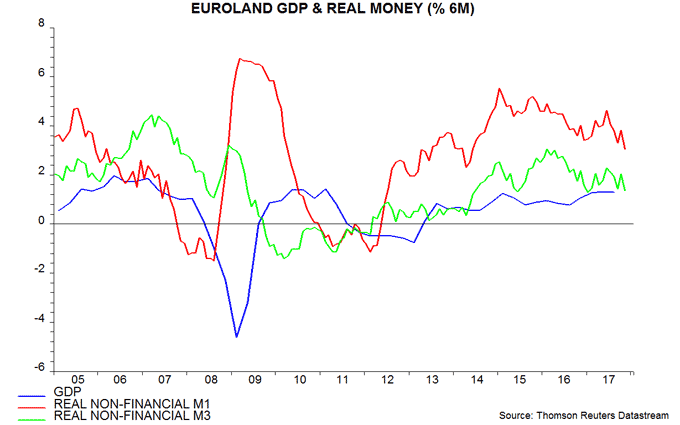
Broad money developments give a similar message, with six-month growth of real non-financial M3 also weakening since June. The slowdown in the real money measures reflects both softer nominal monetary expansion and a rebound in six-month consumer price inflation – second chart.
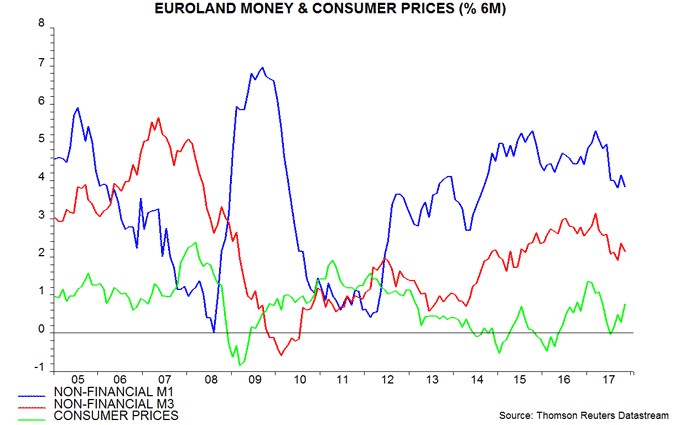
Monetary trends are not signalling economic weakness – real money growth remains solid by historical standards. The consensus forecast of 2.1% GDP growth in 2018, however, may be over-optimistic. The consensus expects GDP to have risen by 2.3% in 2017.
Country data show that real M1 deposit growth has fallen recently in France and to a lesser extent Spain, suggesting that the boost to economic optimism from the election of President Macron is fading, while the Catalonia political crisis is dampening Spanish prospects. Real money growth in German and Italy has been relatively stable – third chart.
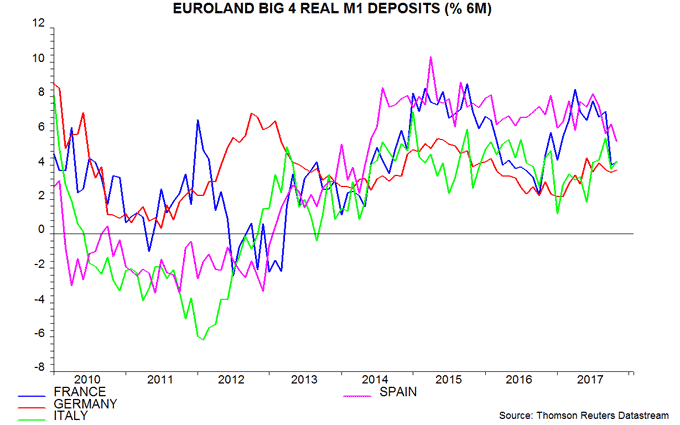
The Citigroup Euroland economic surprise index remains in positive territory but appears to have peaked and has been surpassed by a resurgent US index, as had been suggested by earlier monetary trends – fourth chart. The Euroland index will probably fall further and may turn negative in early 2018, based on recent monetary cooling.
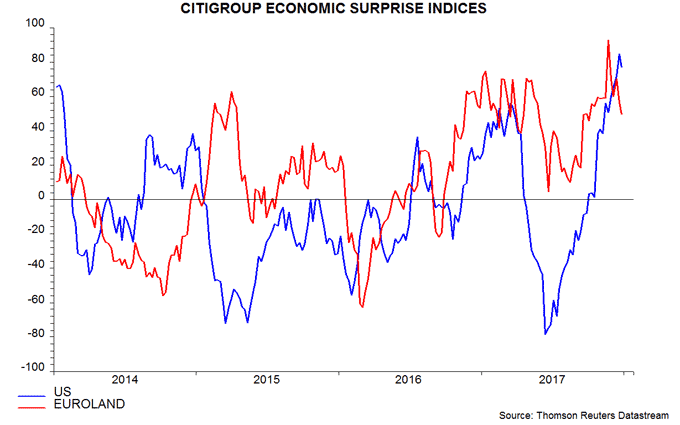
Global growth near peak - are US tax cuts well-timed?
The favoured scenario for 2018 here is that global economic growth will moderate from around March while core consumer price inflation will rise through the year, causing major central banks – with the possible exception of the PBoC – to remain on a tightening tack. Three recent data developments lend support to this scenario.
First, global (i.e. G7 plus emerging E7) six-month real narrow money growth appears to have fallen further in November, based on monetary data covering two-thirds of aggregate tracked here – see first chart. The November drop reflected roughly equally a slowdown in nominal money expansion and a pick-up in six-month consumer price inflation, mainly due to stronger oil prices. Allowing for an average nine-month lead, the decline in real money growth from a most recent peak in June suggests that six-month industrial output expansion will moderate from March through August, at least.

Secondly, the slowdown signal from monetary trends is now receiving tentative confirmation from a shorter-term leading indicator derived from the OECD’s country leading indicator indices. Six-month growth of this indicator is estimated to have risen slightly further in November but one-month growth eased for a second month – second chart. The indicator typically leads by three to five months so the incipient softening is consistent with a loss of economic momentum in spring 2018.

Thirdly, G7 annual core producer price inflation* rose again in November and is well above its level in mid-2016; increases in the core PPI rate over 1999-2000, 2003-05, 2009-11 and 2013-14 were followed by a pick-up in core CPI inflation starting about a year later – third chart.
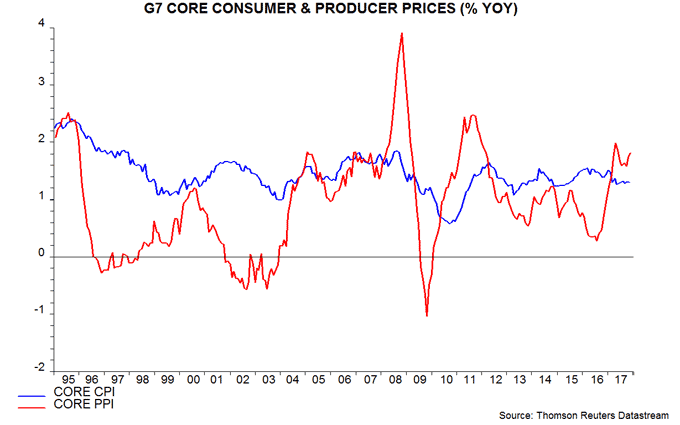
An obvious question is whether US tax cuts will mitigate or reverse the forecast global economic slowdown. A rise in spending intentions of US corporations and / or households would be expected to be signalled by a rebound in US real narrow money growth in early 2018. Such a rebound would suggest a revival of US and possibly global economic momentum in late 2018, i.e. the signal of a slowdown over the spring / summer would remain valid.
The view here is that the US / global stockbuilding cycle will peak in the first half of 2018 and act as an increasing drag on growth in late 2018 / 2019 – see previous post. On this basis, and assuming that the stimulative impact arrives in late 2018, tax cuts may prove to be well-timed – contrary to the consensus view. The bias here is to expect the effect to be insufficient to outweigh the stocks cycle downswing and drags from rising inflation and monetary policy tightening, implying that spring / summer economic weakening will extend into 2019; a firm judgement, however, will be deferred pending early 2018 monetary data.
*GDP-weighted average of US producer prices of finished goods excluding food and energy and closest available series in other G7 economies.
Chinese money trends suggesting stable outlook
Chinese monetary and regulatory policy tightening in 2017 has raised fears of a sharp economic slowdown in 2018. Monetary trends do not currently support such worries. Narrow and broad money measures are rising at a pace consistent with moderate nominal economic expansion*. An easing of inflationary pressures could allow the authorities to step off the policy brakes in the first half of 2018, assuming that the currency remains stable.
Policy was tightened from late 2016 to cool excessively strong nominal economic growth and discourage capital outflows, which were threatening currency stability. Six-month growth rates of narrow and broad money fell significantly through spring 2017, with this slowdown subsequently reflected in a moderation in nominal GDP expansion – see first chart.

Narrow money growth has fallen slightly further in recent months but remains at a respectable level by historical standards and far above levels reached in late 2014 / early 2015, ahead of significant economic weakness. Broad money growth was worryingly low in the summer but has recovered to match narrow money expansion.
Based on these trends, previous posts (e.g. here) suggested that nominal GDP expansion would stabilise in late 2017 / early 2018. November activity and price data are consistent with this forecast: the product of industrial output and producer prices is a rough proxy for nominal GDP and its growth has revived since the summer – second chart.

Annual narrow money growth leads trends in annual growth of house prices, industrial profits and producer prices – third chart. With money growth still cooling, house prices are likely to slow further in the first half of 2018, while producer price inflation should moderate. The authorities may respond by partially reversing recent policy tightening, assuming that the balance of payments position remains stable. Such a reversal could support commodity prices despite restrained economic expansion.

*The preferred narrow and broad money measures are M1 plus household demand deposits (referred to here as true M1) and M2 minus financial sector deposits plus bank bonds. The exclusion of household deposits from the official M1 measure suggests that it will not adequately reflect consumer spending prospects. Financial sector M2 deposits have shown significant volatility in recent years but appear to contain little information about near-term economic prospects. A switch out of time deposits into bank bonds, meanwhile, may have depressed M2 growth.
Simple forecasting rule suggesting stable UK growth
A simple forecasting rule-of-thumb based on money growth and share prices is giving a neutral message for 2018 economic prospects.
The forecasting rule classifies the outlook for GDP growth in the following calendar year as good, bad or average depending on whether December levels of real (i.e. inflation-adjusted) money growth and share prices are higher or lower than 12 months earlier. Real money growth is measured by the annual rate of change of the broad M4ex measure deflated by the retail prices index excluding mortgage interest (RPIX). Share prices are measured by the FTSE local UK index, constituents of which derive at least 70% of sales from the UK and the rest of Europe, again deflated by the December RPIX*.
Annual GDP growth averaged 2.3% in the 51 calendar years from 1966 to 2016. The forecasting rule gave a “double-positive” signal for 16 of these years (i.e. both real money growth and share prices at the end of the prior year were higher than 12 months before). GDP growth in these years averaged 3.8%.
There were, by contrast, 11 years for which the forecasting rule gave a “double-negative” signal. Growth in these years averaged just 0.3%. In the remaining 24 years for which the money supply and share prices gave conflicting signals, GDP expansion averaged 2.3%, in line with the long-term mean.
The rule has continued to perform respectably in recent years. A double-negative warning was given at end-2008 ahead of a 4.2% GDP slump in 2009. A double-positive at end-2012, meanwhile, signalled that growth would pick up significantly in 2013 – contrary to prevailing angst about a double-dip recession.
The rule suggested that 2017 would be an average year: real M4ex growth rose from 2.5% to 4.5% between December 2015 and December 2016 but real share prices fell by 10.4% – the FTSE local UK index, unlike the FTSE 100 and all-share indices, did not enjoy a currency-driven “Brexit bounce”**. The average GDP growth outcome historically for this combination was 1.9%. The current consensus estimate of 2017 GDP growth is 1.6% – below the average but above a consensus forecast of 1.2% in December 2016***.
The rule is also giving a neutral message for 2018, although this will not be confirmed until late January, when December monetary data are released. As of October, annual real M4ex growth had fallen to zero, from 4.5% in December 2016 – see chart. The average level of the FTSE local UK index so far in December, meanwhile, is 4.3% higher than in December 2016. Assuming that annual RPIX inflation in December is equal to or lower than its November level of 4.0%, therefore, real share prices are on course for a marginal annual gain.
The average GDP growth outcome historically for the combination of negative monetary and positive share price signals was 2.4%. The current consensus forecast for 2018 is significantly weaker, at 1.4%.
A double-negative combination is still possible, though unlikely. The FTSE local UK index would need to average 2% less than yesterday’s level (13 December) over the remainder of the month to result in a real-terms decline compared with December 2016, assuming stable RPIX inflation.
*The FTSE local UK index goes back to 1994. The FT 30 index, which is also domestically orientated, was used for earlier years.
**Local UK stocks account for only 22% of the market capitalisation of the FTSE all-share index.
***Consensus numbers from the Treasury’s monthly survey of forecasters.
Euro at risk from distortionary ECB policy
ECB monetary policy is grotesquely misaligned with economic conditions. Monetary laxity threatens to reverse a recent strengthening of the balance of payments basic balance, suggesting euro weakness.
GDP grew by 2.6% in the year to the third quarter, mainly reflecting strength in domestic final demand, which rose by 2.3% – see first chart. Such growth is well above “potential” economic expansion estimated by the OECD, IMF and EU Commission at 1.0%, 1.3% and 1.4% respectively in 2017.

Sustained solid growth of domestic final demand since 2014 – before the ECB embarked on QE – contrasts with an anaemic recovery in 2010-11 after the 2008-09 recession. ECB policy tightening in 2011 was clearly premature and resulted in another recession. This mistake was corrected in 2012-13 under incoming ECB President Draghi – narrow money growth surged, signalling the economic pick-up from 2014.
The subsequent move to negative rates combined with large-scale QE was not warranted by monetary trends and may have overinflated asset prices while laying the foundation for a medium-term inflation overshoot.
The annual increase in the GDP deflator, a broad measure of domestic prices, rose to 1.3% in the third quarter from 0.6% a year earlier – second chart. A similar pick-up in 2014-15 was aborted by pass-through of lower energy costs against the backdrop of a weak labour market. Input cost pressures are currently the strongest since 2011, according to the November purchasing managers’ survey, while labour market slack has fallen significantly since 2015 – third chart.
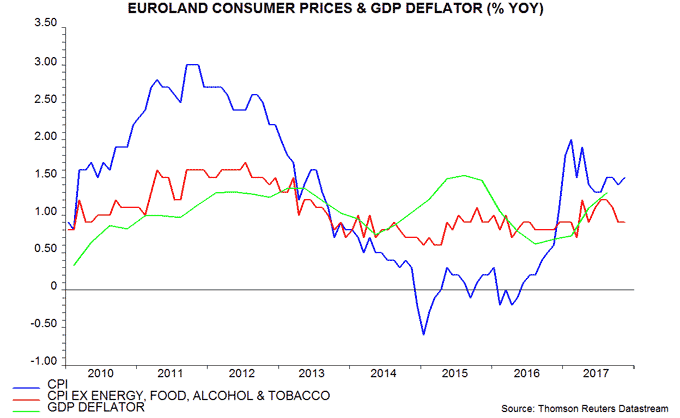
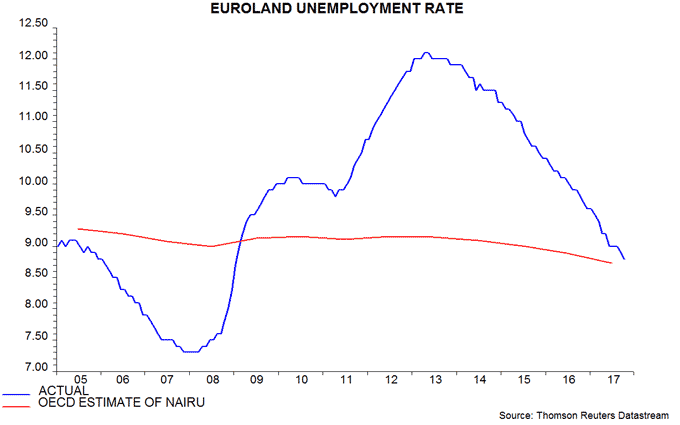
Annual nominal GDP growth moved up to 3.9% in the third quarter, the equal highest since 2008. Stable, strong narrow money growth suggests that nominal GDP will continue to expand robustly – fourth chart. Current growth, if sustained, would imply a rise in inflation to 2.5% or more over the medium term, assuming potential economic expansion of 1.0-1.4% per annum.

The rise in nominal GDP growth has opened up a record 3.2 percentage point gap with a debt-weighted average of Euroland 7-10 government bond yields, which have detached from economic reality because of negative rates and QE – fifth chart.
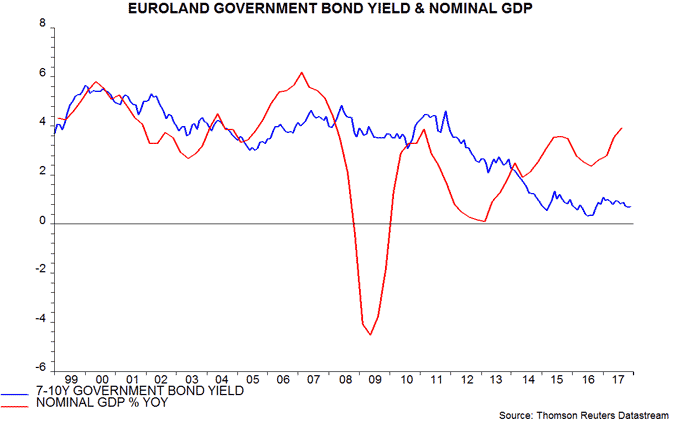
A post in January suggested that the euro, yen and renminbi would rise against the US dollar in 2017, reflecting a narrowing of balance of payments basic balance deficits. The basic balance is the sum of the current account balance and net direct and portfolio investment flows. The Euroland and Chinese basic balance deficits have indeed fallen, while Japan’s balance has moved into surplus.
According to monetary theory, the basic balance position is determined by the difference between domestic credit expansion (i.e. the growth of bank lending to the domestic public and private sectors) and growth in domestic residents’ demand to hold bank liabilities (i.e. broad money plus non-monetary liabilities such as bank bonds). Faster expansion of domestic credit than demand to hold bank liabilities creates “excess” liquidity that is, in effect, exported by running a basic balance deficit.
The earlier post suggested that Euroland domestic credit would slow in 2017 because of ECB QE tapering, while demand for bank liabilities would be boosted by faster nominal GDP expansion. These suggestions have played out – sixth chart. The narrower credit / liabilities growth gap “explains” the decline in the basic balance deficit – seventh chart.
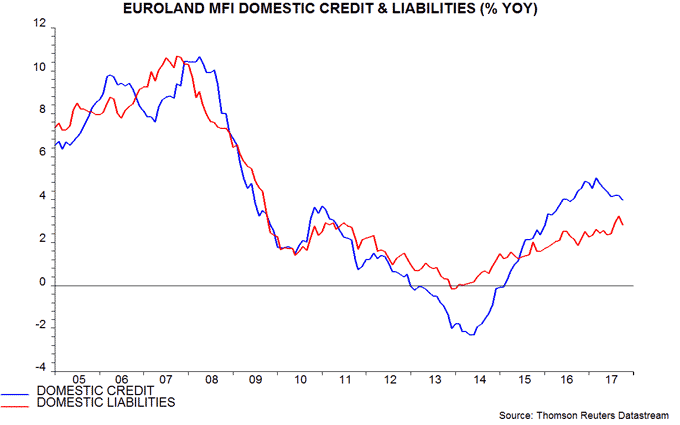
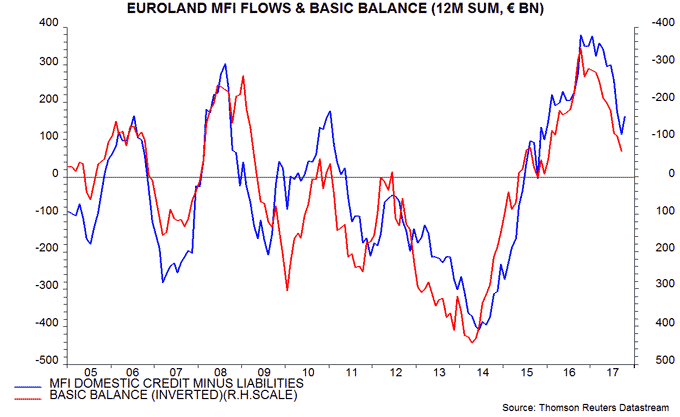
Lower QE from January may result in a further reduction in credit expansion to governments but private lending growth may pick up in lagged response to current economic strength – ECB research found a 1-2 quarter average historical lag between GDP growth and real private loan expansion. The demand to hold broad money and bank bonds, meanwhile, may be depressed by the ECB’s commitment to maintain current negative rates at least through September 2018, despite rising inflation. The fall in the domestic credit / liabilities growth gap, therefore, may stall.
Relative credit / money demand trends may favour the US dollar rather than the euro in 2018. The planned reduction in the Fed’s balance sheet in 2018 is comparable in scale with the slowdown in ECB QE between 2017 and 2018, suggesting a similar drag on domestic credit expansion. US residents’ demand to hold broad money and other bank liabilities, however, may be boosted by rising nominal / real interest rates and repatriation of corporate foreign earnings due to tax reform.
Global money trends signalling economic growth peak
The consensus view is that 2018 will be another year of strong and broadly-based global economic growth. Monetary trends and cycle analysis, by contrast, suggest that early robust momentum will fade as the year progresses.
As indicated by earlier partial data, global (i.e. G7 plus emerging E7) six-month real narrow money growth edged up in October after falling between June and September. Real money momentum turning points have led turning points in industrial output momentum by an average of nine months since 2005 – see first and second charts*. The June peak, therefore, suggests that six-month industrial output growth, which has moderated since the summer, will reach another peak around March 2018.
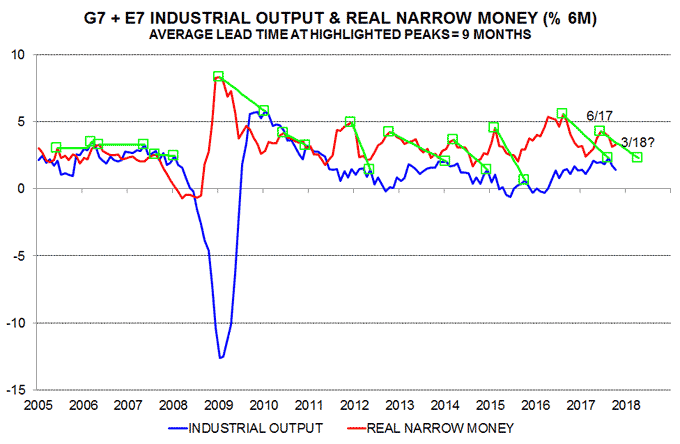
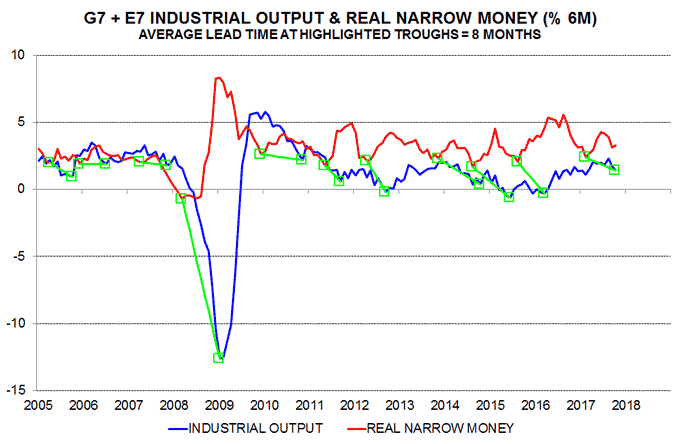
With global real narrow money growth still respectable in October, a post-March economic slowdown may initially be modest. Recent commodity price gains, however, may push up six-month consumer price inflation further, implying an increased drag on real money growth assuming stable nominal expansion – third chart. Nominal narrow money trends, meanwhile, could weaken if slowing QE leads to a reduction in risk appetite and broad money velocity – fourth chart.
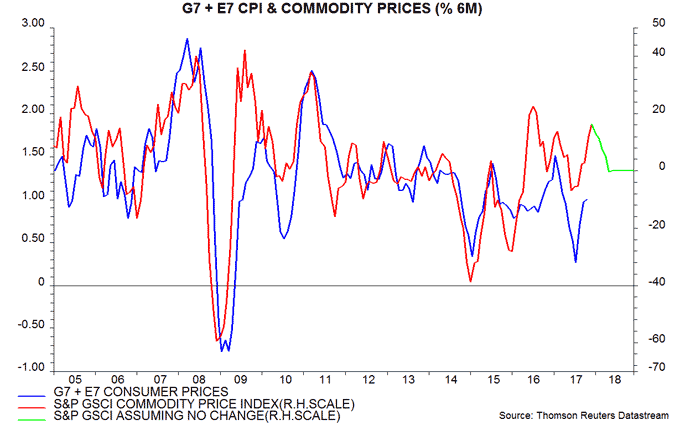
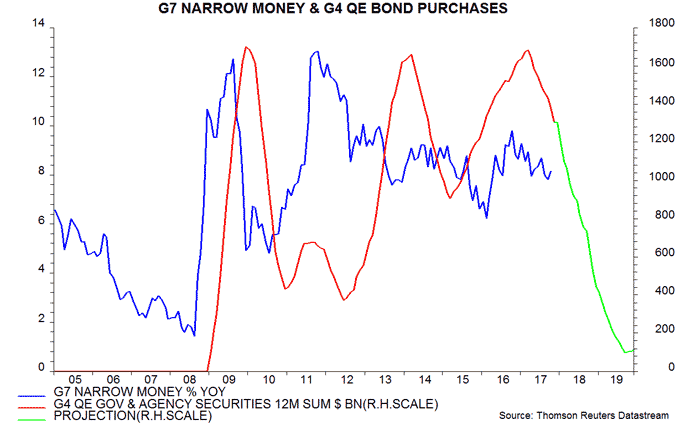
The suggestion that economic momentum will peak by the end of the first quarter is consistent with the assessment here that the US / global stockbuilding cycle is approaching the end of its upswing phase. The cycle has an average duration of 13-14 quarters and probably bottomed in early 2016 – see previous post.
Upward pressure on unit labour cost growth and core inflation may be sustained well beyond an economic growth peak, reflecting stretched labour markets. The G7 unemployment rate fell further in October and is well below major lows reached in the 1990, 2000 and 2007 – fifth chart.

Headline inflation prospects may depend partly on Chinese policy developments. Narrow money trends are signalling a slowdown in house prices, industrial profits and producer prices into early 2018 – see previous post. The authorities may respond by partially reversing monetary and regulatory policy tightening in 2017, in which case global commodity prices may strengthen further despite peaking economic growth, with such strength sustaining upward pressure on G7 headline inflation and policy rates.
Put differently, Chinese policy tightening may have relieved pressure on G7 central banks in 2017; the reverse may be true in 2018.
The recent fall in global six-month real narrow money growth reflects declines in both the G7 and E7 but the G7 / E7 gap remains slightly positive, casting doubt on recommendations to be overweight emerging market equities – sixth chart.
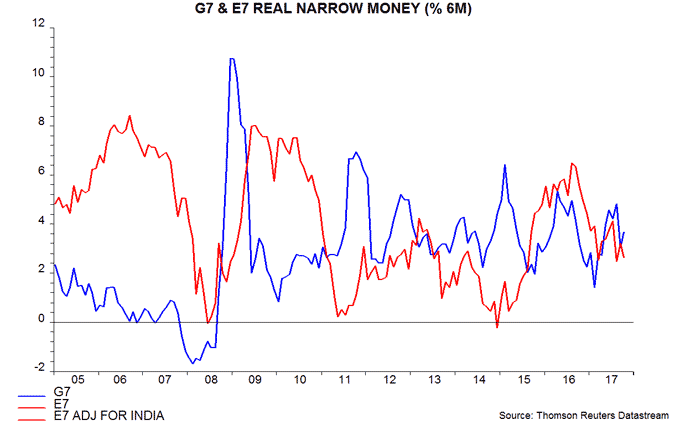
The range of variation in six-month real narrow money growth across the major economies is unusually small: October growth was equal in the US, Japan, Euroland and China, with the UK only modestly lower – seventh chart. Among other developed economies, real money growth has weakened in Australia and to a lesser extent Canada but is strong in Switzerland – eighth chart.
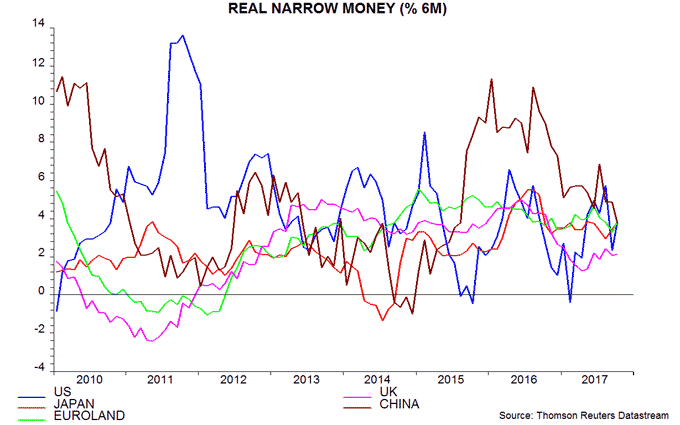
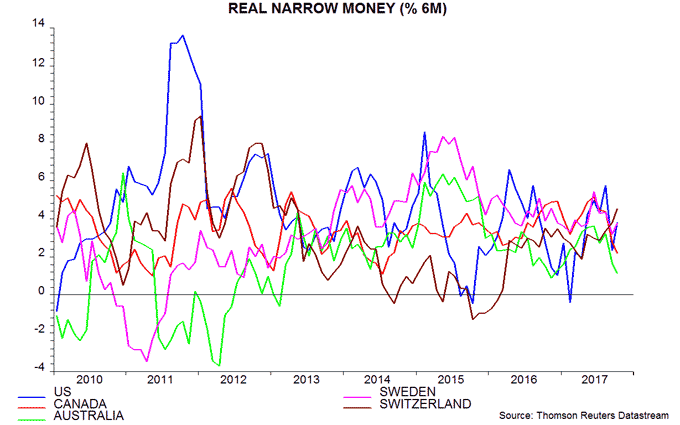
*The series shown incorporate adjustments to exclude temporary large falls in Japanese industrial output in 2011 and Indian narrow money M1 in 2016 due respectively to the March 2011 Tohoku earthquake / tsunami and the November 2016 demonetisation programme. An average lead of nine months was also found in a longer-term (50 year) study of G7-only data.


